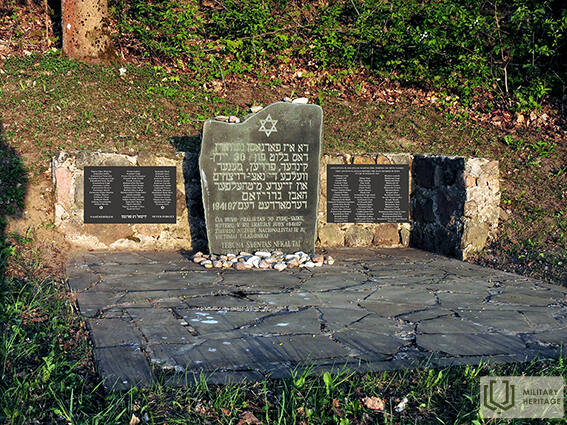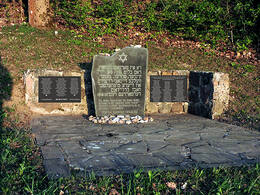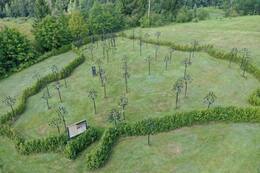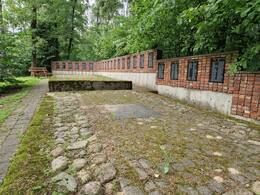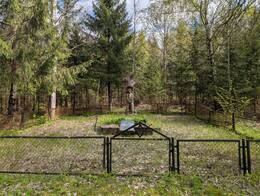The tragedy of the Jews of Plateliai
In July 1941, 30 local Jews were murdered on Jazminų Hill in the town of Plateliai, and the place later became memorable for the tragic events that occurred there.
"The fate of everyone is the same. At first, as was customary, they gathered the men, right here near Plateliai, you see, where the monument stands - they shot them there. A couple of weeks later, they took the women, children, and the elderly here, outside Plateliai, a few kilometers away, into the forest, and shot them all there," says Eugenijus Bunka, the son of Holocaust survivor folk artist Jakovas Bunka. According to E. Bunka's stories collected from local Plateliai residents, at first all the Jews of Plateliai were herded into the Plateliai synagogue. First, they shot the men in the town of Plateliai itself, at the foot of Jazminų Hill. The women, children, and the elderly remained, people who could not resist.
E. Bunka remembers a story told by a local boy named Baužys, who was then still a boy. He became one of the witnesses who saw what happened on Jazminų Hill. Baužys, together with several children from Platelia, watched the Jews being lined up in the town on the day of the massacre. Seeing where they were being led, the children ran and hid in the grass near Jazminų Hill and watched what was happening. After what they saw, the children, lying in the tall grass, were afraid to even move, lest they suffer the same fate.
After the massacre, the bodies of the people were thrown into a pit. All the executioners eventually dispersed, and one was left to guard the pit. While sitting, the guard got drunk and began to doze. At that moment, a man emerged from the pit, alive, but covered in blood and intoxicated. Instead of running in the opposite direction, he started walking towards the guard. The guard woke up. Realizing that a man was approaching him, he pulled out his rifle, shot him in cold blood, and threw him back into the pit...
Related timeline
Related objects
Plateliai Jewish massacre site and graves (Jazminai Hill)
A hill called Jazminų kalnas, located on the outskirts of the town of Plateliai. At the foot of the hill in July 1941, 30 Jews from Plateliai were shot (some of the Jews from Plateliai were shot on the Laumalenkai Peninsula). During the interwar period, about 100 Jews lived in Plateliai, but “[…] the fate of all was the same. At first, as was customary, they gathered the men, right here near Plateliai, you see, where the monument stands – they shot them there. A couple of weeks later, they took the women, children, and the elderly here, outside Plateliai, a few kilometers away into the forest, and shot everyone there,” said Eugenijus Bunka, the son of Holocaust survivor folk artist Jakovas Bunka.
Around 1985, his father, folk artist Jakovas Bunka, carved and erected a decorative sculpture of Moses on the mountain. In 2016, the sculpture collapsed, and in 2018, a copy, carved by folk artist Antanas Vaškis, was erected.
At the foot of the mountain, a monumental granite slab was also erected in memory of the Jewish genocide, with inscriptions in Yiddish and Lithuanian: "The blood of 30 Jews – children, women, men – was shed here. They were brutally murdered by nationalists and their local collaborators in July 1941. May the memory of the innocent victims be sacred." In 2019, two more granite slabs were added with a list of Jews living in Plateliai in 1939.
Litvak Memorial Garden
In 2014, the Jacob Bunka Charity and Support Foundation established the Litvak (Lithuanian Jew) Memorial Garden in Žemaitija National Park, approximately two kilometres from the centre of Plateliai, in the village of Medsėdžiai. It is a monument dedicated to the eliminated Jewish communities of Lithuania. The garden reproduces the contours of Lithuania, while the sites where Jewish communities were eliminated in 1941–1944 are marked with wrought-iron apple trees. The author of the carved apple trees is Artūras Platakis. The apples in the trees signify families that have lived in these communities. Litvaks from around the globe can participate in the development of the garden by ordering new apple trees and apples in memory of their ancestors. The garden also features pillars made of Karelian granite that individually celebrate the achievements of Litvaks worldwide.
In 2016, the initiative was extended to include the Litvaks, who lived throughout the territory of the Grand Duchy of Lithuania, and the rescuers of Jews during the Holocaust. A billboard at the entrance to the garden tells the story of former Jewish communities throughout Lithuania.
Currently, apple trees to commemorate the Jewish communities of Alytus, Alsėdžiai, Kalvarija, Mosėdis, Plateliai, Plungė, Telšiai, Vabalninkas, Viekšniai, and others have “grown” at the garden.
Kaušėnai Holocaust Memorial
In the village of Kaušėnai (Plungė district), a memorial to the victims of the Kaušėnai Holocaust has been established at the site of the murder of the Jews. The memorial is dedicated to the Jewish communities of Plungė and the surrounding villages that were destroyed during World War II.
The memorial was established based on the initiative of the last Jew of Plungė, Jakovas Bunka. The first monument to the victims of the Second World War was erected in 1952, and in 1986–1989, a memorial to commemorate the murdered Jews was created from oak monuments. 1,800 bricks of the demolished Plungė Synagogue were used to build the Memorial Wall in 2011, where each brick is dedicated to the memory of someone murdered,
and plaques with the known names of 1,200 (out of 1,800) Jews are affixed to the wall. The Alleyway of the Rescuers is located near the memorial, and the names of those who rescued the condemned Jews in Plungė and its surroundings during the Nazi occupation are inscribed on the posts in the alleyway.
On 12 and 13 July 1941, about 1,800 Jews from the Plungė district were murdered on Kaušėnai Hill, having been held for two weeks in brutal conditions in the Plungė synagogue before that. On the day of the genocide, those who could were made to walk five kilometres to the place of execution, while the rest were transported in separate groups by lorry. The victims were ordered to dig their own graves and then they were shot.
The memorial is one of the ten most impressive memorials in Europe reflecting the tragedy of the Jewish people.
Graves of Holocaust victims in Šateikiai
The site and grave of the massacre of women and children of the Salantai Jewish community is a historical cemetery of Holocaust victims in the northwestern part of the territory of the Plungė district municipality, in Šateikiai Rūdaičiai (Plateliai eldership), 0.5 km northeast of the Skuodas-Klaipėda road, on the northwestern edge of the Šateikiai forest.
The gravesite is rectangular in plan, 10 x 10 m in size, surrounded by a wire mesh fence. In its northwestern part, there are metal, openwork, single-leaf gates, the upper part of which depicts the Star of David. The Star of David and a memorial inscription in Yiddish and Lithuanian are carved on the monumental granite slab. In 1980, a wooden sculpture depicting a standing Jew with his hands tied was erected (author - folk artist Jakovas Bunka). The area of the territory is 0.01 ha.
In this place, in July–August 1941, auxiliary policemen from Salantai and Šateikiai killed women and children of the Salantai Jewish community. The execution took place in three stages. The first massacre took place around July 20, 1941. On the orders of the police, carters with carts arrived from the villages at dawn near the Salantai synagogue, where Jewish women and children were being held, and, accompanied by auxiliary policemen, took about 60–70 women to Šateikiai Forest. During the second massacre, at the end of July, the last remaining women and children in the ghetto were killed, more than 50 of them. At the end of August, auxiliary policemen escorted about 100 Jewish women from Salantai to Šateikiai Forest for execution. Since July, they had been working as auxiliary agricultural workers at the Šalynas Manor and with farmers in the Salantai Rural Municipality.
According to the Holocaust Atlas in Lithuania, 95 victims are buried here. The memorial plaque at the gravesite and the document collection "Mass Massacres in Lithuania" indicate that 100 Jewish men, women and children were killed here. Paulius Vaniuchinas, a researcher of the history of Salantai, determined that 210–220 women and children were killed at this site.
The site of the massacre and burial was declared a historical monument of local importance in 1970 and registered in the register of cultural heritage in 1993.




